shortsguy1
Jedi Hopeful
Offline
I have access to my Healey 3000 BJ8 for the next few days but am unable to do any major projects on the car. So instead, I am just trying to diagnose why my car will get too hot quite quickly when stopped and at idle. Today, my goal was to understand the coolant and oil temperatures of the car at idle after a drive. I put together a few thermocouples and read their values to learn a few things about my car. I have no idea if this is of any value to anyone else, but on the off chance....
1) My oil cooler does nothing to address overheating when parked at idle. My oil cooler is mounted between the frame rails, slightly below the radiator. At idle, the inlet and exit temps of the cooler were identical, suggesting that the engine fan causes no air flow through the oil cooler. I have the stainless flex fan currently installed.
2) The temperature gauge in my car is shockingly accurate up to 225 F. Above 225F, it appears to stop moving, even though the scale goes to 230 F. (I know these are high temps and should be avoided, but that is the whole problem with my car. You cannot avoid them if you drive in summer.)
3) Using an IR thermometer reading the side of the top tank gives the correct temperature of the coolant exiting the engine. I compared this with a thermocouple inside the radiator (I had the rad cap off for some of this) and a thermocouple under the upper rad hose at the radiator and all three measurements were identical. So for others trying to figure out if their Smiths gauge is accurate, you can compare with an IR thermometer shined at the side of the top tank with good results.
4) The temperature drop through my radiator at idle is 5-6 degrees F. I don't yet know what to make of this result, but it was a little smaller than I expected.
5) The oil temps are consistently less than the coolant temps. I would stop an experiment when the car reached 225 F, and the oil temperature was always 190-195F at this point. So I guess my point is that even though the car's coolant is extremely hot, the oil is probably still doing fine.
6) Closing off the coolant bypass had ZERO observable effect on the rate at which my car overheats at idle, after a drive. I did the same short loop today with the bypass open and with the bypass closed. It is very hot here today, so the car was at 195 F when I pulled to a stop. Within 5 minutes, the car had always reached 225F, regardless of the status of the bypass. So it is strange to say, but closing off the bypass doesn't make much (or perhaps any) difference in my car. So I won't be rushing off to purchase one of those rather expensive bellows thermostats with the bypass ring.
Tomorrow, I plan to measure air velocities through the radiator and measure an array of temperatures in front of the radiator. My eventual goal is to figure out if hot air is recirculating through the radiator. I am trying to be systematic and solve this little puzzle one change at a time. Thanks for reading.
1) My oil cooler does nothing to address overheating when parked at idle. My oil cooler is mounted between the frame rails, slightly below the radiator. At idle, the inlet and exit temps of the cooler were identical, suggesting that the engine fan causes no air flow through the oil cooler. I have the stainless flex fan currently installed.
2) The temperature gauge in my car is shockingly accurate up to 225 F. Above 225F, it appears to stop moving, even though the scale goes to 230 F. (I know these are high temps and should be avoided, but that is the whole problem with my car. You cannot avoid them if you drive in summer.)
3) Using an IR thermometer reading the side of the top tank gives the correct temperature of the coolant exiting the engine. I compared this with a thermocouple inside the radiator (I had the rad cap off for some of this) and a thermocouple under the upper rad hose at the radiator and all three measurements were identical. So for others trying to figure out if their Smiths gauge is accurate, you can compare with an IR thermometer shined at the side of the top tank with good results.
4) The temperature drop through my radiator at idle is 5-6 degrees F. I don't yet know what to make of this result, but it was a little smaller than I expected.
5) The oil temps are consistently less than the coolant temps. I would stop an experiment when the car reached 225 F, and the oil temperature was always 190-195F at this point. So I guess my point is that even though the car's coolant is extremely hot, the oil is probably still doing fine.
6) Closing off the coolant bypass had ZERO observable effect on the rate at which my car overheats at idle, after a drive. I did the same short loop today with the bypass open and with the bypass closed. It is very hot here today, so the car was at 195 F when I pulled to a stop. Within 5 minutes, the car had always reached 225F, regardless of the status of the bypass. So it is strange to say, but closing off the bypass doesn't make much (or perhaps any) difference in my car. So I won't be rushing off to purchase one of those rather expensive bellows thermostats with the bypass ring.
Tomorrow, I plan to measure air velocities through the radiator and measure an array of temperatures in front of the radiator. My eventual goal is to figure out if hot air is recirculating through the radiator. I am trying to be systematic and solve this little puzzle one change at a time. Thanks for reading.

 Hey there Guest!
Hey there Guest!
 smilie in place of the real @
smilie in place of the real @
 Pretty Please - add it to our Events forum(s) and add to the calendar! >>
Pretty Please - add it to our Events forum(s) and add to the calendar! >> 
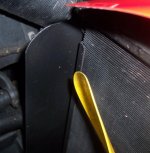
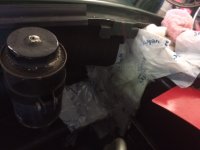
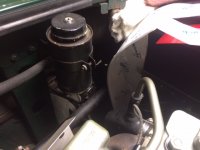
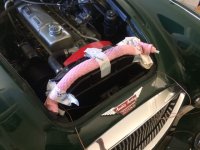
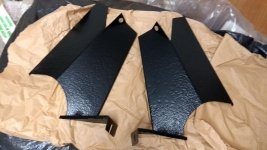
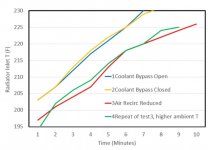



 A friendly reminder - be careful what links you click on here. If a link is posted by someone you don't know, or the URL looks fishy, DON'T CLICK. Spammers sometimes post links that lead to sites that can infect your computer, so be mindful what you click.
A friendly reminder - be careful what links you click on here. If a link is posted by someone you don't know, or the URL looks fishy, DON'T CLICK. Spammers sometimes post links that lead to sites that can infect your computer, so be mindful what you click.